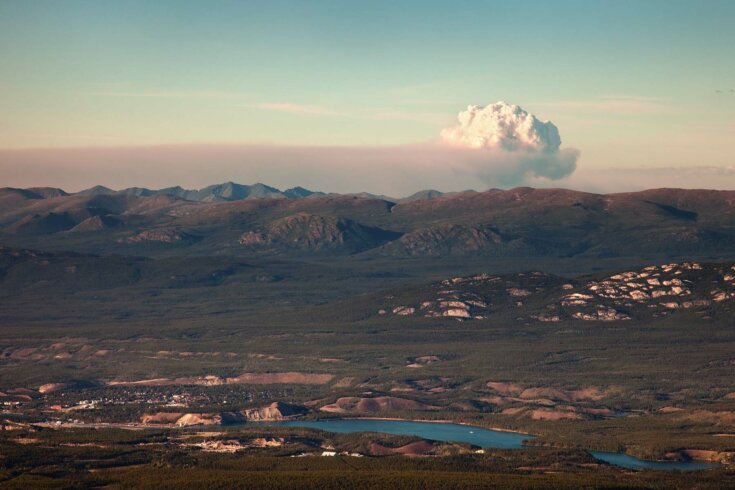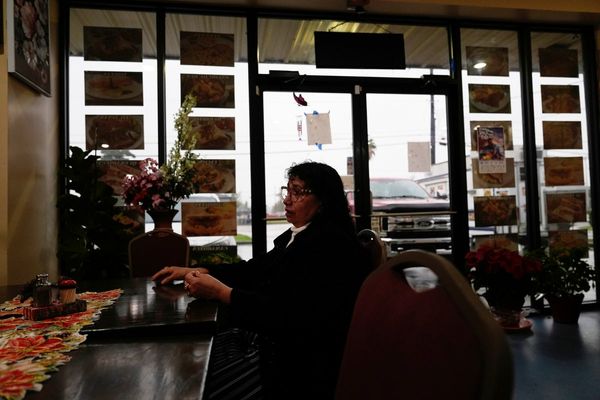
When I moved to Whitehorse in 2009, I’d never imagined having to plot out a household wildfire evacuation plan. I don’t remember noticing a particularly smoky season until the summer of 2013, when fires around the smaller community of Carmacks, two hours north, left a brown haze in the capital city’s atmosphere and the taste of barbecue in the air. The next summer, I wrote about the mushroom-hunting boom that had inevitably followed those fires: the morels popping up in the burn zones a year later were plucked by sweaty, ash-smeared pickers and sold for cash along the roadside to professional buyers who’d rolled into the territory from British Columbia. But I treated both the smoke and the morel boom that followed as curiosities rather than omens.
The North’s relative lack of human-built spaces, compared to more heavily used southern areas, shapes our relationship to wildfire. Here in the Yukon, since most of our fires result from lightning strikes and burn deep in wilderness without threatening any infrastructure, the authorities just let them burn themselves out most of the time. Unlike more rigorous regimens of fire suppression, that passivity supports the boreal forest in its natural cycle of renewal. And since roads are often a vector for the ignition of new fires, our scant northern highway coverage can be preventative too.
For most of the past decade, my awareness of wildfires and the risks they pose has grown in a gentle upward curve. I followed the harrowing news from Fort McMurray in 2016. That was probably the first time I confronted the theoretical idea that I might someday have to flee and that my adoptive hometown could be destroyed. Two summers later, the residents of Telegraph Creek, a day’s drive south of Whitehorse, in northern BC, were evacuated before fires devastated their emptied-out town. I remember spotting handwritten signs on posterboards taped up at intersections in my neighbourhood, directing the evacuees who’d made their way to Whitehorse to a school gym to register themselves.
That same summer, 2018, was when I first felt real personal vulnerability. In August, I spent two weeks, during a heat wave, dog-sitting for friends in a remote off-grid cabin. I could smell the smoke of large fires burning maybe 50 or 100 kilometres away, and if I’d been somewhere with cell service, radio reception, reliable internet access, or even a landline telephone, I might have been less twitchy. But I wondered: Out here, if a fire came closer, and then closer still, how would I know? Sometimes I’d lie awake, chilled by my own unanswerable questions. If I woke in the night and sensed danger, how quickly could I get us from the cabin to my car, and down the long driveway to the road? (I’ve since learned that part of the answer, in rural areas of the Yukon at least, is that officials will go door to door to give affected residents a heads-up about nearby fires and the risks they might sooner or later pose.)
Later that year, in November, when the Camp Fire seared its way through northern California, killing more than eighty people, I started paying more attention. At the time, I lived in a Whitehorse neighbourhood that lay across the Yukon River from most of the rest of the city, surrounded on three sides by forest. For the first time, in the spring, I thought about the upcoming fire season, and I sat down and made a list of things I would need if I had to leave in a hurry. I couldn’t quite summon the organizational capacity to create a government-recommended emergency kit, with enough food, water, medications, and other supplies to last seventy-two hours, but I figured if I did my thinking now, while clear headed and calm, I wouldn’t have to worry about leaving something important—my passport, my phone charger—behind. I put the list up on my fridge: my modest, first ever attempt at wildfire preparedness. It made me feel a little better.
Last summer’s record-setting fire season, bookended by the fires in urban Halifax and the horrors of the Lahaina fire in Maui, was a palpable shift for many of us. In the North, that shock may have been especially acute. At one point last year, nearly 70 percent of the entire population of the Northwest Territories had been evacuated from their homes, including all of the capital city of Yellowknife. Some people made their way from one community to another, only to have to evacuate a second time; many others spent weeks away from home. The Yukon’s season was less dramatic in comparison, but it still included the evacuations of the communities of Mayo and Old Crow—the latter a fly-in community, with all the attendant logistical challenges—as well as the emergency removal of staff from a major working mine.
Old Crow was evacuated pre-emptively by the local First Nation, not because of an immediate threat but because of the daunting challenges of evacuating a fly-in village if conditions worsened. The city of Yellowknife, too, made the call to send its residents away in part because of the vulnerability of the long, lone road leading south: a thin thread through a burning landscape.
This spring, I suspect a lot of us in the North are thinking about the thin threads that connect our communities to one another: two-lane roads, twin-prop planes, small ferries across rivers that have never seen a permanent bridge. I’ve wondered if my own heightened awareness is partly because of my wife, whose work means she is sometimes involved in wildfire response. But I don’t think it’s just me. On Facebook and on telephone poles around town, I see notices posted about neighbourhood wildfire awareness meetings. With snow still dusting the ground, local news outlets are already publishing stories about the state of the territory’s wildfire preparedness and the lessons learned from last year. It feels like we’re gearing up together.
The more I consciously prepare, the more the creeping dread I experienced during those earlier years has faded away. I no longer catch myself, late at night, wondering how quickly I could cram the dog and the cat into the back seat of the car and peel out of town. Instead, I feel a kind of steadiness. We know that fire seasons can be hard and scary and that they may yet get harder and scarier. That’s not going to change anytime soon. But we also know we can get through them.
Recently, going through a mess of papers in my office, I found that note I’d put up on my fridge back in the spring of 2019, listing my must-haves in the event I had to prepare to leave town. I pulled it out of the pile, making a mental note: it’s due for an update.
With thanks to the Gordon Foundation for supporting the work of writers from Canada’s North.







